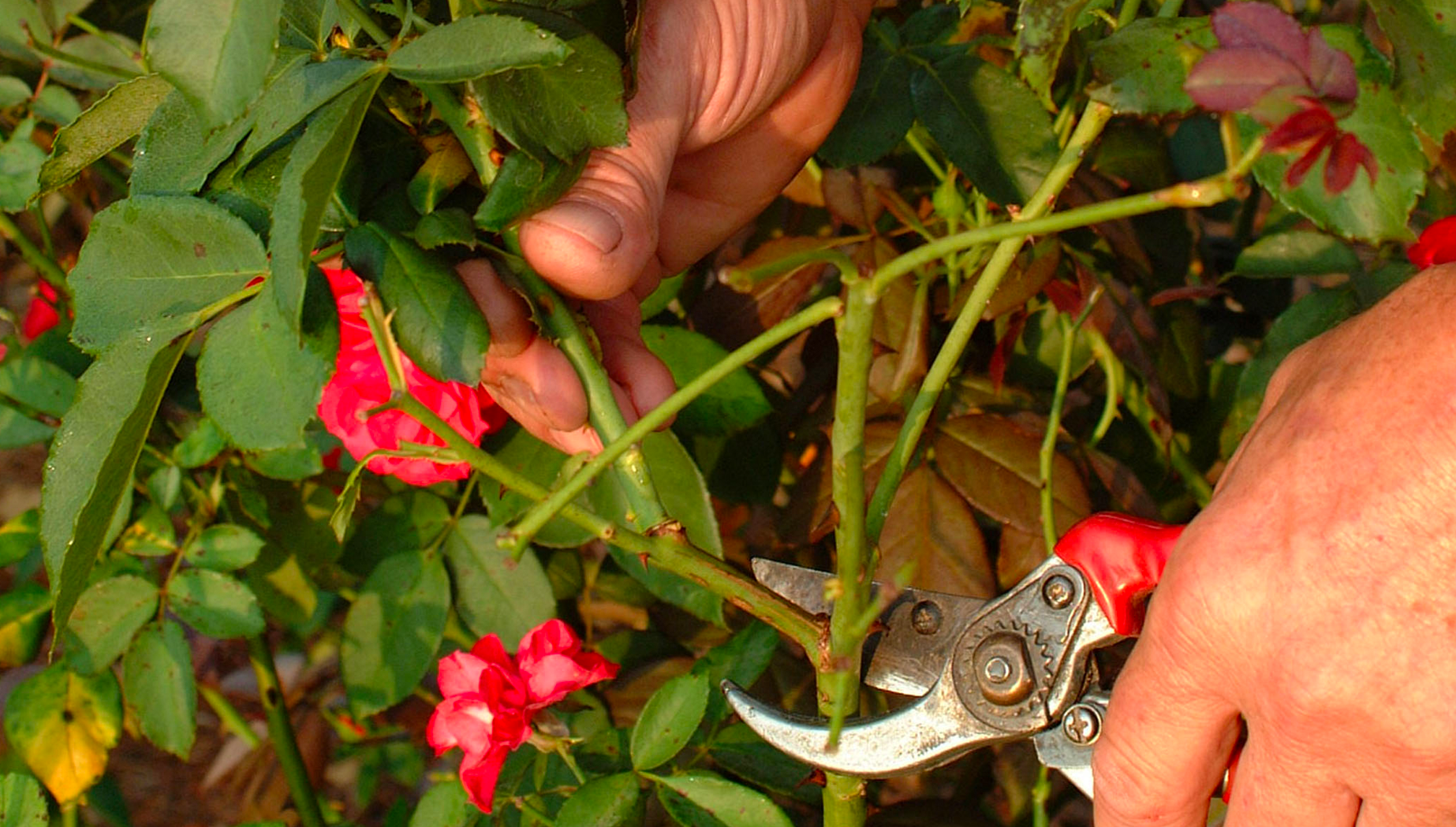Pruning roses is not difficult, however, it is a task many find daunting due to the vast amounts of information and opinions available on the topic. To be honest, you cannot really prune a rose wrong. Pruning does not harm the rose at all, you will not kill the rose by pruning – so don’t stress!
Pruning is best done mid to late winter or early spring – remember to hold off until the most severe frosts have passed in frost prone areas.
Why Prune?
Pruning is a highly effective way of:
- controlling the size and neatness of the bush
- maximising flower production and encouraging strong growth
By decreasing the size of the rose, the plant has less eyes that require sap flow in spring. This results in stronger stem production and therefore more flowers.
During its life span, the rose will produce continuous water shoots (or basal shoots) from the bud union at the base of the plant, forming the beginning of new stems. Fresh rose stems claim most of the sap flow, producing long stems with large quality flowers.
Overtime the sap flow will gradually decrease and the stem will become exhausted. You will notice that old stems lose their vigour, producing short twiggy shoots, with smaller, fewer flowers and the bark turning grey before eventually dying off.
The procedure of pruning is to help accelerate this process, aiding the rose to produce higher quality flowers, foliage and stems. This is done by removing aged grey stems, allowing the plant to put all its energy into the new growth.
How To Prune:
Remember:
- When pruning always cut slightly above the growth eye (or growth bud) as this where new growth will begin to appear. Growth eyes occur where there is, or was, a leaf growing from the stem. Try to select a growth eye that is facing outwards.
- If in doubt of which stems to remove, always remove the oldest grey branch. The newer branches will produce stronger growth and more flowers.
- If plants have had black spot or mildew – or any other fungal disease – during the growing season, the fungal spores will stay in your garden. Be sure to collect all clippings after pruning and burn them. This will help stop the spread of disease around your garden.
Bush Roses
By bush roses we are referring to floribunda, hybrid tea and modern shrub roses.
The process of pruning is not difficult. We have simplified it into the following points:
- Remove 2/3 of plant height.
- Remove any remaining foliage.
- Remove any dead wood or diseased wood, making a cut right to the base of the stem.
- Remove any spindly, untidy shoots to their base.
- Remove old branches that are not performing – leave the newest stems.
- To reduce crowding in the center of the plant, remove any branches that cross over others.
- Remove suckers. Click here for more information.
There are exceptions to the above points, keep reading to find out more.
Heritage, Old Fashioned, Species Varieties
These require little to no pruning. Remove any old or dead wood. However, for a neater look, prune as per bush roses.
For roses that only flower in spring, winter pruning will reduce the number of flowers. For these roses, only remove the dead and very old twiggy wood. For best results, prune once the spring flowering is over. A very light trimming to keep the plant neat may be necessary, be sure to keep it light.
Climbing Roses
Firstly, we need to understand the difference between the main canes and the lateral canes
Main canes: are the support and structure of the rose, generally produced from the base of the plant. These stems do not produce many flowers.
Lateral canes: these canes grow from the main canes and are the stems that produce flowers.
It is important to remember that we do not want to prune the main canes, ONLY the lateral canes.
Climbing roses need to be trained to produce the desired effect. This is done by weaving or tying new canes horizontally to a support – a fence, wall, pillar, etc.
- Remove any dead wood or diseases, making the cut right to the base of the stem.
- Remove old stems that are unproductive. Look for the new canes that will replace the ones being removed.
- Trim back lateral growth leaving the side stems no longer than about 6-8 cm and with a minimum of three growth buds.
- On the new main canes, cut the tips down to the first side shoot.
- Remove suckers.
- Rearrange the remaining stems, tying them to a support. Aim for the main canes to lie horizontally along the support, as this will encourage more shoots to grow creating a thicker, bushier look. Roses do not grow down wards; therefore, do not bend them further then horizontal.
Ramblers
Ramblers rarely flower twice on the same stem. For this reason, it may be necessary to cut the stems that have recently flowered back to their base or to the next strong shoot. This is to be done immediately after flowering has finished. Be sure to train the new shoots to replace the stems that have been removed.
Ground Covers
Ground covers need little to no pruning. Remove dead heads – these are the spent flowers left on the push – and light trimming to keep them tidy.
Standard Roses
Standards are pruned in the same way as bush roses.
All standards need to be staked as they cannot support their own weight, snapping in strong winds. When pruning be sure to replace the ties, this will stop the tie becoming too tight around the stem which can reduce the sap flow, stunting the growth of the rose.
Weeping Standard Roses
Most weeping standards are ramblers, climbers or ground cover varieties.
Weepers perform their best when unpruned and therefore they require little to no pruning.
Remove dead wood and old twiggy stems after flowering. Dead heading and very light trimming to keep it tidy may also be necessary on some varieties.
What to do after pruning:
Spray:
After completing pruning during winter it is best to spray roses with Lime Sulphur. This helps to eliminate fungal spores and eggs from pests, giving you a fresh start come spring. This is especially important for rose gardens that have trouble with black spot and mildew during the growing season.
Follow the instruction on the packaging and spray every stem on each rose, making sure to also spray the surrounding ground.
Note: this spray may defoliate the rose plant if used during the growing season, hence why we suggest spraying Lime Sulphur only after pruning in winter.
Seamungus:
Seamungus is an organic soil conditioner and used for roses as a winter fertiliser. This helps your plants resist frost, pests and disease as well as conditioning the soil and encouraging root growth, giving them a head start for spring.
Mulch:
Applying a new layer of mulch. Mulch works as an insulator, protecting from temperature variations and helping to retain moisture in the soil, preventing damage to roots during hot weather and drought conditions. Garden beds that are well mulched will require less watering and weeding. Mulching your roses will also help to provide them with necessary nutrients as the matter begins to break down into the soil. Click here for more information on mulching.
Water:
After pruning your roses give them a good deep soaking of water. Once pruned, this is a good time to start regularly watering your roses again. This will help them to break dormancy and produce flowers quicker into spring.
Potted Roses:
Each winter it is best to assess your potted roses and their performance. If they have performed poorly over the last year chances are they are pot bound, meaning they do not have enough room available in the pot for their roots. If this is the case re-potting them into a larger pot will do your plant wonders. After pruning is a great time to do this.
Overtime the potting mix will settle and you will notice the soil level sinks into the pot. Depending on how far it has sunk either top up the soil or remove the plant, add more potting mix to the base and replant the rose.
Remember to water the plant well after doing either of these tasks!
During the flowering season:
Roses often do not require pruning during the flowering or growing months. Throughout the season be sure to dead head and remove any die back as it occurs.
Dead Heading
Dead heading is the process of removing spent flowers. Old flowers left on the bush will begin to turn into hips and seeds, taking up most of the plants energy. The removal of spent flowers encourages more blooms to grow, maximising flower production. Snap or cut off the flower where the first leaflets are found.
Die Back
Die back is the blackening of the tip of the rose stem which then travels down toward the graft. The most common cause of die back is a lack of water. Click here for more information on die back.

